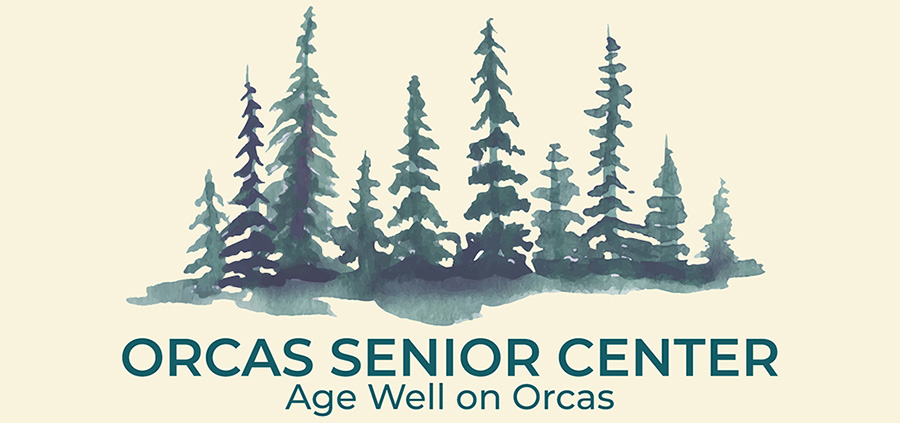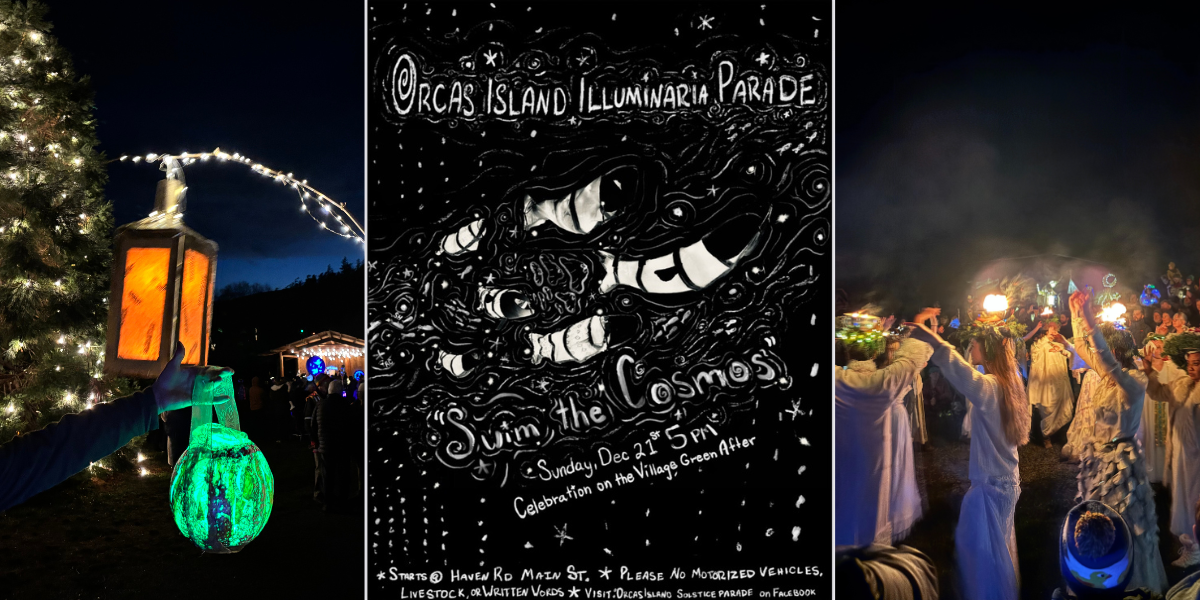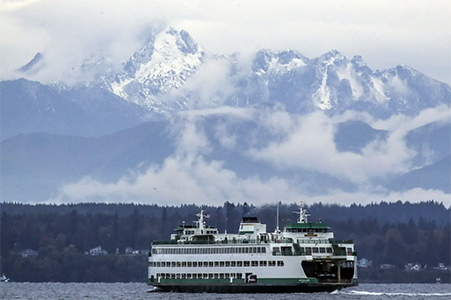By Margie Doyle
On June 7, the Eagle Forum held its annual meeting and heard from Jay Kimball about OPALCO’s revised plan to expand broadband to members, and from Daniel Himebaugh with the Pacific Legal Foundation about the outlook for the county for county lands designated as National Monuments.
About two dozen people attended the meeting at Odd Fellows Hall. President Rick Boucher said the bywords for this year are “Standing Room Only,” and explained, “if you’re sitting down, you’re not paying attention.” Boucher added,that conservative people don’t get much acknowledgement, and that the Eagle Forum on Orcas was started in 2011, in part due to the frustration with the Republican viewpoint. Boucher said, “We’re more libertarian, and wanted a conservative viewpoint recognized.”
The Orcas Eagle Forum’s founding documents state that conservatives work to find common ground, and debate national, state, regional and local issues. It is “a voice for truth and liberty through education,” Boucher said.
He gave a special award to Dick Doty, for his willingness to argue for his stand, saying “Dick represents the people that don’t talk a lot.”
The first speaker was Daniel Himebaugh of the Pacific Legal Foundation (PLF), formed in the 70s and operating in Washington State since 1992 as a “public interest legal organization, a counterpoint to liberal public interest legal organizations, with the mission of “changing the trajectory of law in the courts. ”
After speaking about the work and cases the Pacific Legal Foundation (PlF) undertakes, Daniel spoke about the “new San Juans national monument, from a constitutional and legal approach.”
He cited Alexander Hamilton, who wrote in Federalist paper #78 that limitations on government can be preserved in practice through the courts. He spoke of cases where the principles of a reasonable connection and proportionate remedies were upheld by the PLFs’ representation in the courts.
Himebaugh then turned to the approximately 1,000 acres throughout the San Juan Islands, that, pieced together, have been designated a National Monument. He said that the designation requires the Bureau of Land Management (BLM) to develop a management plan, which “closes off the monument area from resource development and sales.”
The BLM will take public input in this process.
In addition, the Critical Areas Ordinance update in San Juan County is being monitored as it proceeds through court cases; the PLF is also watching o the progress of the Shoreline Management Plan (SMP) in San Juan Couunty.
OPALCO to Increase Broadband Access Incrementally
Jay Kimball then described the new plan that Orcas Power and Light Cooperative (OPALCO) proposes to increase internet access (broadband) to its members. He first described the current broadband situation:
- Internet use has grown 32 percent per year in recent years, a steep increase;
- A quantity of 10.6 megabits per second was pledged in 2006; in San Juan County, most subscribers get 1-2 megabits per second, only Friday Harbor and Eastsound are close to 10 mb/sec.
- Since 2001, OPALCO has added fiber network in its system, and made that available to emergency facilities, community centers and private businesses
- Several years ago, the County Economic Development Council (EDC) and the San Juan Island Community Foundation led the initiative to increase broadband throughout the county because they saw increased broadband directly linked to economic viability
- CenturyTel has been inundated with demands on its internet systems, and is “data exhausted.”
- When OPALCO proposed extending a hybrid fiber optic cable and wireless system to its members earlier this year, it was based on a cost of $34 million for such a system; a fiber-only system was estimated to cost $74 million
- OPALCO garnered about 20 percent of its membership willing to invest in the hybrid system.
As announced at the beginning of the hybrid buy-in initiative, OPALCO needed 50 percent buy-in to proceed. Not having reached that point, they have decided instead to move incrementally toward providing high-speed access for all co-op members.
The next step in that mission is to work with private Internet service providers (ISPs) such as Orcas Online, Rock Island and the Computer Place, among others, to increase the access.
It will do this by adding more fiber accessibility in the middle of the access system, thereby removing the bottleneck that exists in acquiring internet access, especially in the evenings. “The ‘middle mile’ is the problem,” said Kimball. By growing the fiber network incrementally, ultimately its access will be universal, and OPALCO will sell the access to wholesale “customers.”
In response to questions from the audience, Kimball said that by announcing its hybrid system buy-in earlier this year to its members, OPALCO “got the attention” of broadband providers and “shook things up.”
He urged audience members to attend the OPALCO community forum meetings on
- Monday June 17 from 5 to 7 p.m. at Roche Harbor Resort on San Juan Island
- Tuesday, June 18 from 5 to 7 p.m. at Woodman Hall on Lopez Island
- Wednesday June 19 from 5 to 7 p.m. at the Senior Center on Orcas Island
**If you are reading theOrcasonian for free, thank your fellow islanders. If you would like to support theOrcasonian CLICK HERE to set your modestly-priced, voluntary subscription. Otherwise, no worries; we’re happy to share with you.**








Hi Margie, Thanks for covering the OPALCO Broadband discussion.
I want to add to what you said about broadband speed in the county and the nation. In 2011, the national average for homes and businesses was 10.6 Mbps. Since then, it has been increasing at about 32% per year. Islanders are getting speed so slow that it is only about 10% of what mainlanders are getting.
The Economic Development Council (EDC) and San Juan Community Foundation approached OPALCO 2 years ago because they knew we had been operating a fiber and telephone network throughout the islands, since 2001. OPALCO uses that network to manage the grid, and provide gigabit service to local ISPs, CenturyLink, schools, libraries, SJC government, local businesses, and UW.
As I am sure you know, rural community economics and property values are hit hard when broadband is poor. For more on this, and why rural communities are being left behind when it comes to affordable broadband, I recommend checking out this interview with Susan Crawford: https://billmoyers.com/segment/susan-crawford-on-why-u-s-internet-access-is-slow-costly-and-unfair/
There are three parts to OPALCO’s New Direction that the board is considering:
The first is providing OPALCO high-speed fiber infrastructure to CenturyLink to speed up their backbone – the middle mile – that feeds neighborhoods throughout the county with DSL. Since most people in the county currently connect to the internet via DSL, this is a way to help CenturyLink improve the speed and reliability of their DSL services, and has the potential to quickly improve broadband service for at least two thirds of islanders.
Second, OPALCO is considering providing state of the art wireless broadband to the local ISPs. Or fiber and for their wireless access points that currently serve their customers. This helps level the playing field and provide an alternative to islanders that don’t have good access to or want DSL services from CenturyLink.
Providing fiber to CenturyLink, and wireless broadband to the local ISPs, would be done via lease agreements. In effect, OPALCO is WHOLESALING its broadband infrastructure to these service providers in exchange for longterm commitments, that help us grow our broadband network in a low risk managed way. Though we are in serious discussion with these folks, what they choose to do is ultimately up to them.
The third part of the new direction the board is considering, is whether to provide broadband services via RETAIL. As you may know, OPALCO has provided high-speed fiber services to business, schools, libraries, and our local government for over a decade. The board is considering expanding this retail set of services to more businesses and homes, especially those that are not getting adequate broadband services from CenturyLink or the local ISPs. This would be done at cost of service. We are still working out what those costs would be and more detail will be forthcoming.
So that’s it in a nutshell – leasing fiber and wireless to CenturyLink and the local ISPs, and retailing to homes and businesses as needed. There are lots of details to work out, and as we do, we want to hear from our members.
Jay Kimball
OPALCO Broadband Team